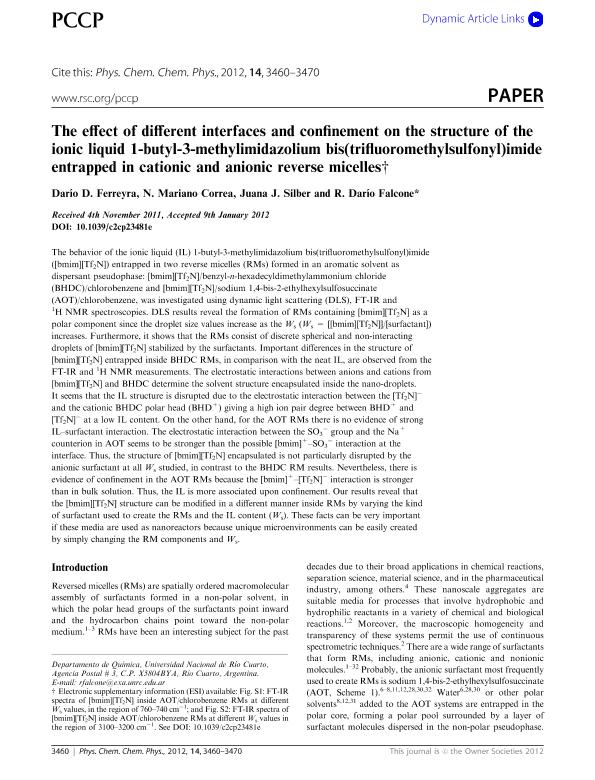Mostrar el registro sencillo del ítem
dc.contributor.author
Ferreyra, Darío David

dc.contributor.author
Correa, Nestor Mariano

dc.contributor.author
Silber, Juana J.
dc.contributor.author
Falcone, Ruben Dario

dc.date.available
2023-06-12T13:30:26Z
dc.date.issued
2012-03
dc.identifier.citation
Ferreyra, Darío David; Correa, Nestor Mariano; Silber, Juana J.; Falcone, Ruben Dario; The Effect of Different Interfaces and Confinement on the Structure of the Ionic Liquid 1-butyl-3-methylimidazolium bis(trifluoromethylsulfonyl)imide Entrapped in Cationic and Anionic Reverse Micelles.; Royal Society of Chemistry; Physical Chemistry Chemical Physics; 14; 10; 3-2012; 3460-3470
dc.identifier.issn
1463-9076
dc.identifier.uri
http://hdl.handle.net/11336/200259
dc.description.abstract
The behavior of the ionic liquid (IL) 1-butyl-3-methylimidazolium bis(trifluoromethylsulfonyl)imide ([bmim][Tf 2N]) entrapped in two reverse micelles (RMs) formed in an aromatic solvent as dispersant pseudophase: [bmim][Tf 2N]/benzyl-n-hexadecyldimethylammonium chloride (BHDC)/chlorobenzene and [bmim][Tf 2N]/sodium 1,4-bis-2- ethylhexylsulfosuccinate (AOT)/chlorobenzene, was investigated using dynamic light scattering (DLS), FT-IR and 1H NMR spectroscopies. DLS results reveal the formation of RMs containing [bmim][Tf 2N] as a polar component since the droplet size values increase as the W s (W s = [[bmim][Tf 2N]]/[surfactant]) increases. Furthermore, it shows that the RMs consist of discrete spherical and non-interacting droplets of [bmim][Tf 2N] stabilized by the surfactants. Important differences in the structure of [bmim][Tf 2N] entrapped inside BHDC RMs, in comparison with the neat IL, are observed from the FT-IR and 1H NMR measurements. The electrostatic interactions between anions and cations from [bmim][Tf 2N] and BHDC determine the solvent structure encapsulated inside the nano-droplets. It seems that the IL structure is disrupted due to the electrostatic interaction between the [Tf 2N] - and the cationic BHDC polar head (BHD +) giving a high ion pair degree between BHD + and [Tf 2N] - at a low IL content. On the other hand, for the AOT RMs there is no evidence of strong IL-surfactant interaction. The electrostatic interaction between the SO 3 - group and the Na + counterion in AOT seems to be stronger than the possible [bmim] +-SO 3 - interaction at the interface. Thus, the structure of [bmim][Tf 2N] encapsulated is not particularly disrupted by the anionic surfactant at all W s studied, in contrast to the BHDC RM results. Nevertheless, there is evidence of confinement in the AOT RMs because the [bmim] +-[Tf 2N] - interaction is stronger than in bulk solution. Thus, the IL is more associated upon confinement. Our results reveal that the [bmim][Tf 2N] structure can be modified in a different manner inside RMs by varying the kind of surfactant used to create the RMs and the IL content (W s). These facts can be very important if these media are used as nanoreactors because unique microenvironments can be easily created by simply changing the RM components and W s.
dc.format
application/pdf
dc.language.iso
eng
dc.publisher
Royal Society of Chemistry

dc.rights
info:eu-repo/semantics/openAccess
dc.rights.uri
https://creativecommons.org/licenses/by-nc-sa/2.5/ar/
dc.subject
Liquidos ionicos
dc.subject
AOT
dc.subject
BHDC
dc.subject.classification
Físico-Química, Ciencia de los Polímeros, Electroquímica

dc.subject.classification
Ciencias Químicas

dc.subject.classification
CIENCIAS NATURALES Y EXACTAS

dc.title
The Effect of Different Interfaces and Confinement on the Structure of the Ionic Liquid 1-butyl-3-methylimidazolium bis(trifluoromethylsulfonyl)imide Entrapped in Cationic and Anionic Reverse Micelles.
dc.type
info:eu-repo/semantics/article
dc.type
info:ar-repo/semantics/artículo
dc.type
info:eu-repo/semantics/publishedVersion
dc.date.updated
2023-06-07T15:15:48Z
dc.journal.volume
14
dc.journal.number
10
dc.journal.pagination
3460-3470
dc.journal.pais
Reino Unido

dc.journal.ciudad
Cambridge
dc.description.fil
Fil: Ferreyra, Darío David. Universidad Nacional de Río Cuarto. Facultad de Ciencias Exactas Fisicoquímicas y Naturales. Departamento de Química; Argentina. Consejo Nacional de Investigaciones Científicas y Técnicas. Centro Científico Tecnológico Conicet - Córdoba; Argentina
dc.description.fil
Fil: Correa, Nestor Mariano. Universidad Nacional de Río Cuarto. Facultad de Ciencias Exactas Fisicoquímicas y Naturales. Departamento de Química; Argentina. Consejo Nacional de Investigaciones Científicas y Técnicas. Centro Científico Tecnológico Conicet - Córdoba; Argentina
dc.description.fil
Fil: Silber, Juana J.. Universidad Nacional de Río Cuarto. Facultad de Ciencias Exactas Fisicoquímicas y Naturales. Departamento de Química; Argentina
dc.description.fil
Fil: Falcone, Ruben Dario. Universidad Nacional de Río Cuarto. Facultad de Ciencias Exactas Fisicoquímicas y Naturales. Departamento de Química; Argentina. Consejo Nacional de Investigaciones Científicas y Técnicas. Centro Científico Tecnológico Conicet - Córdoba; Argentina
dc.journal.title
Physical Chemistry Chemical Physics

dc.relation.alternativeid
info:eu-repo/semantics/altIdentifier/url/https://pubs.rsc.org/en/content/articlelanding/2012/cp/c2cp23481e
dc.relation.alternativeid
info:eu-repo/semantics/altIdentifier/doi/http://dx.doi.org/10.1039/C2CP23481E
Archivos asociados
